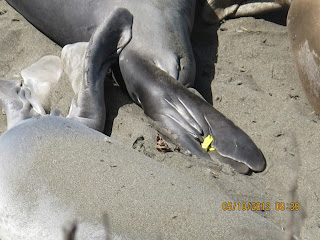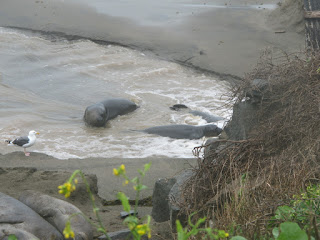California had King Tides in December, and more will happen January 10, 11 and 12. I took photos of some local places during the December tides, comparing high and low tides:
Leffingwell Landing. I had to back up when I came returned for the low tide picture, in order to show the tide line., so the photos are not from exactly the same vantage point.
San Simeon Cove, looking north from the pier.
San Simeon Cove, looking south from the pier.
Piedras Blancas elephant seal rookery.
I'll repeat this on the tides in January.
Tuesday, December 27, 2016
Wednesday, December 21, 2016
Green Tie is back!
Green Tie, an elephant seal bull who was initially rescued from plastic entangled around his neck in 2011 is back on the north beach at Piedras Blancas. He's easily recognizable because of the unique double scar from the green plastic that cut deep into his flesh.
Rescuers gave him the name after freeing him from the plastic. He got attention in 2012 and 2013, when his scar looked as if it might still have foreign material in it. He was sedated so that the veterinarian could examine him. She determined that the skin was inflamed, a skin fold dermatitis, that posed no threat to him.
In 2011, his weight was estimated at 700 pounds, making him one of the largest seals ever rescued. In 2013, rescuers estimated him at 1,100 pounds. He's really big now, certainly well over a ton.
When he raises up, the scars show clearly that he is no longer entangled. Those scars tell a terrible story, though.
I use him as a teaching animal, explaining to visitors how this happened and what it took to save his life. He's my ambassador for clean oceans.
Being able to recognize an individual makes him feel special. And, in his own way, cute. I wonder whether he will rule a harem this year and mate.
Rescuers gave him the name after freeing him from the plastic. He got attention in 2012 and 2013, when his scar looked as if it might still have foreign material in it. He was sedated so that the veterinarian could examine him. She determined that the skin was inflamed, a skin fold dermatitis, that posed no threat to him.
In 2011, his weight was estimated at 700 pounds, making him one of the largest seals ever rescued. In 2013, rescuers estimated him at 1,100 pounds. He's really big now, certainly well over a ton.
When he raises up, the scars show clearly that he is no longer entangled. Those scars tell a terrible story, though.
I use him as a teaching animal, explaining to visitors how this happened and what it took to save his life. He's my ambassador for clean oceans.
Being able to recognize an individual makes him feel special. And, in his own way, cute. I wonder whether he will rule a harem this year and mate.
Thursday, May 5, 2016
Tagging seals for research
There’s always something different to see at the elephant
seal viewpoint. Beachwalker Elizabeth Bettenhausen spotted this marked seal at
Arroyo Laguna beach in April. Her sighting became part of Patrick Robinson’s
research.
Dr. Robinson, UC Año Nuevo Island Reserve Director and UC
Santa Cruz lecturer, has marked hundreds of flipper-tagged animals each year.
The markings make it easier to identify them from a distance, without
disturbing them. Or, incidentally, putting the observer at any risk. Watch how
Dr. Robinson marks the seals in this video.
“We marked this seal up at Ano Nuevo a few months ago and it
appears to have returned home,” he said. “I'll incorporate this sighting in our
database. Many thanks!”
His research is discovering where seals go, and identifying which
seals are on local beaches. This seal is in a general demographic study.
The dyed markings are temporary. They will peel off with her
skin when she molts, which is happening in April and May.
Elephant seals molt their skin annually in the spring. All
other seals molt, but most do so gradually, so it isn’t as noticeable. Molting
seals show pearl gray new skin underneath the tattered old brown skin, peeling
back.
The new skin is already formed beneath the old skin. Blood
gradually stops flowing to the old skin, and it peels off in pieces. Friends of
the Elephant Seals docents have samples of it to show visitors. Visitors are
welcome to touch it, feel its bristly hairs. Some visitors are reluctant, but
most are willing.
Some of the seals have a color-coded tag on their hind
flippers that indicates where they were born. About three quarters of the seals
return to their birth beach. About ten percent of Piedras Blancas seal pups get
a white tag. All colors of tags show up here. The tags are small, only an inch
and a half long, and can’t be seen when the flippers are folded, as they usually
are when the seals are at rest. Look for a seal stretching its flippers to see
a white, red (San Nicolas Island,) yellow (San Miguel Island), pink (Farallones
Islands and Point Reyes), purple (Gorda) or green (Ano Nuevo) tag.
 |
| This seal got two white tags. |
 |
| This yellow tag indicates the seal was born on San Miguel Island. |
Elephant seals are deep divers, spending their days at 500
to 2,000 feet down in the ocean. That makes them difficult for fragile humans
to follow. We’d be crushed at the pressure, more than 60 times the atmosphere
on the surface. Humans experience serious effects at 100 feet, and even
professional free divers don’t go past 400 feet. Digital tracking equipment
opens opportunities that would otherwise be beyond human observation.
Tell a blue-jacketed docent if you observe unusual markings.
Be part of the adventure of elephant seals.
Published in The Cambrian.
Monday, March 14, 2016
Weaners take over the beach
In March, the uproar of breeding season is past. Weaners have the run of the beach.
The rain we had generated large amounts of runoff from the ranchlands across the highway. But the weaners are grown up enough now that they aren't in any danger. They used the stream for breath-holding practice.
One had trouble climbing out. as he lurched up the sandy side, it collapsed under him.
He finally moved to a section where the bank was shorter and was able to climb out. Another weaner took an interest.
The rain we had generated large amounts of runoff from the ranchlands across the highway. But the weaners are grown up enough now that they aren't in any danger. They used the stream for breath-holding practice.
One had trouble climbing out. as he lurched up the sandy side, it collapsed under him.
He finally moved to a section where the bank was shorter and was able to climb out. Another weaner took an interest.
Thursday, February 25, 2016
Peace on the beach
Breeding season is winding down, and the beach is much calmer. Dominant males are still being challenged by other males, but the level of energy is lower. They care, but not as much. Everyone is tired.
Weaner pups are molting their birth black coats. It's more like shedding than the actual skin peeling off that comes later in life.
Males mate as they can with females before they leave on the next stage of their migration.
We've had some high tides and big waves, but the weaners are able to navigate the beach away from high water. Soon the adults will be gone and they will have the beach to themselves.
Weaner pups are molting their birth black coats. It's more like shedding than the actual skin peeling off that comes later in life.
Males mate as they can with females before they leave on the next stage of their migration.
We've had some high tides and big waves, but the weaners are able to navigate the beach away from high water. Soon the adults will be gone and they will have the beach to themselves.
Wednesday, February 3, 2016
Pups at high tide
Plenty of pups squirm
on the beach in January, under the watchful eyes of their mothers. The bulls
are less concerned, with their attention focused on mating. This year’s high
tides and storms have added to the chaos.
Elephant seal pups
can’t swim when they are born. That inability must be a holdover from their
evolutionary past, when their ancestors were land mammals. As helpless pups,
they are at risk of drowning as waves inundate the beach.
At Piedras Blancas this
year, there’s almost no beach above high tide line at the north end of the
boardwalk. Seals have crowded up next to the fence to stay above the water.
Visitors are thrilled to get such a close look. But bulls battling each other
and mothers shoving each other for space can separate mothers and pups, and
make it difficult for them to reconnect. One docent counted 21 pups in a group
that included only 14 possible mothers last week.
In the limited space
left to mothers and pups, they crowded together to stay out of the waves. Look
for mothers surrounded by three or four pups. Elephant seals give birth only to
a single pup. Twins are unknown. Mothers don’t eat for that month while they
are nursing the pup. They create milk by metabolizing their blubber. Each seal
is plump enough to feed one pup, but not more. Any extra drains her resources
further.
Losing track of each
other is serious, the single most common cause of pup death. Some mothers will
nurse other pups, but other chase them away. Inexperienced mothers may learn
from mothering other pups, but the milk they drink may deprive her own pup of
the food he needs to grow. Some mothers are willing to foster a pup for a few
days. Mothers whose pups die may adopt a stray, or even attempt to steal a pup
from another mother.
Last week, one mother
searched for her pup as the tide receded. Mothers and pups identify each other
by sound and scent. She sniffed around, and barked occasionally. Pups around
her slept on, but she likely reconnected with her little one before the tide
returned. About 95 percent of the pups at Piedras Blancas survive to weaning.
The south end of the
beach has more dry land for pups, so there’s less confusion there. Watch for
the dominant bulls, beachmasters, to defend their harems. That big seal with a
long nose may appear to be asleep, but he knows is some younger interloper
tries to approach a female. He’ll warn the intruder off with a look and a
bellow. If that’s doesn’t work, he’ll rise up and wave his nose. He’ll charge
and attack the younger bull, who may escape or turn to fight.
Read the column in The Cambrian.
Read the column in The Cambrian.
Subscribe to:
Comments (Atom)























